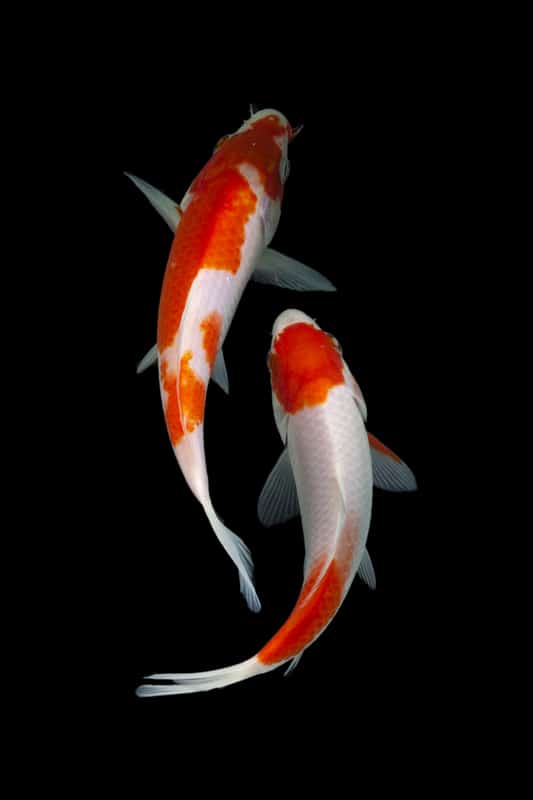
There are over 100 types of Koi species found across the world today, and luckily not all of them are expensive. Sadly, only a few koi species have gained popularity or are deemed good enough to display in a pond. The type of koi will determine if it will be expensive or not.
The most expensive breed of koi fish is the Kōhaku. Some of the most popular kinds of koi can be very expensive. Whatever the kind of koi, you will pay for perfection when they are bred with the right coloration, size, and from a respected lineage. The following koi kinds are expensive:
- Kōhaku Sanke
- Showa
- Tancho
- Doitsu
- Beni Kikokuryu
- Asagi
- Utsuri
- Matsuba
Owning a koi can be a beautiful experience as these fish are pretty to look at, and some even have an element of playfulness top them. They are symbolic of the Japanese culture, found in ponds in many Chinese communities, and well-loved worldwide. Prices range from $100-$15,000 and higher, depending on factors like the breed, coloration, and size.
Pro Tip: If you’re tired of wasting money and making costly mistakes on the koi-keeping hobby or are thinking about buying koi fish but don’t know where to start, I strongly suggest you check out this ebook. I recently read this ebook, and it contains SO much useful information, such as:
- 3 proven steps to identify koi fish diseases
- WARNING: 3 things you should NEVER do when it comes to caring for koi
- When to seek professional help when it comes to looking after your koi
What Kinds Of Koi Is The Most Expensive?
Expensive koi hardly refers to the koi swimming around at your local pet store, rather the koi that’s of show quality. Show koi are judged according to extremely high standards, and the fifty best koi selected from over 50,000 born each year have to be close to perfect.
The most expensive koi are judged to align with what a perfect specimen should present when observed. These koi will be judged by judges that form part of the American Koi Judges Association (AKJA) in the US.
Members of the Shinkokai (US Chapter) have access to the best koi and breeders out there, and typically the koi bought from them will be of a higher quality and more expensive. One such member is Peters and Sons Koi (pskoi.com), which has access to some of the better-produced koi in Japan.
Let us discuss some of the more expensive koi breeds on the market today.
Kōhaku Koi
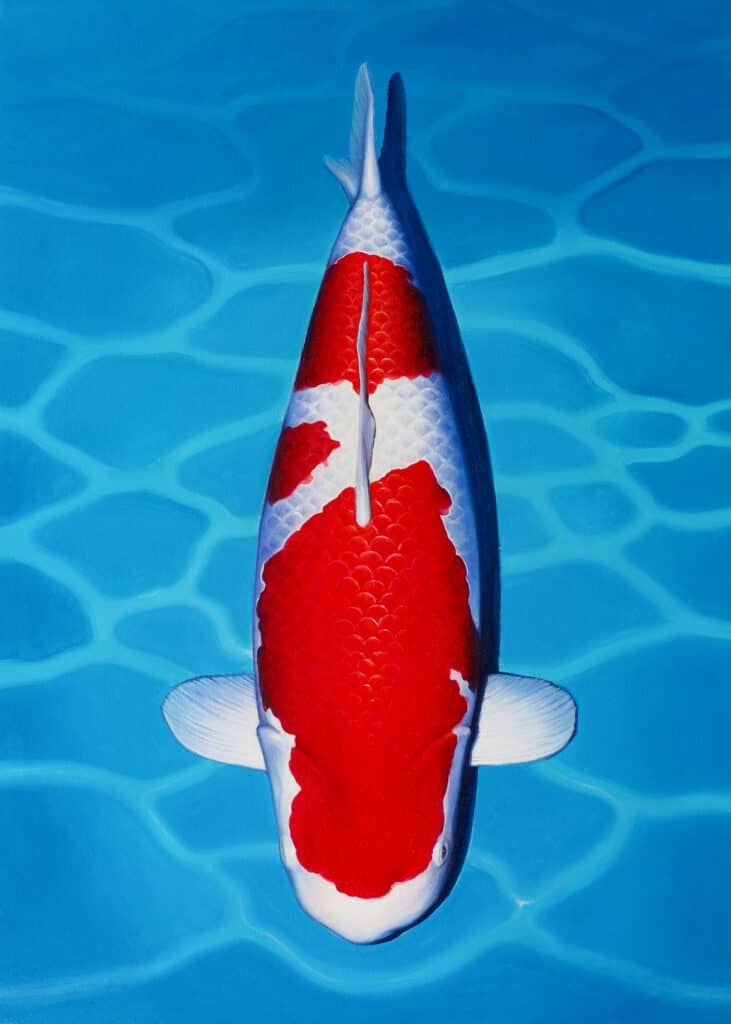
Kōhaku (red – known as hi – and white colors) is considered to be one of the “Big Three” varieties of koi, the other two are:
- Sanke
- Showa
These koi dates back to the 1800s when Kunizo Hiroi took one of his males and bred it with a red-headed female (cherry blossoms markings), believed to be one of the first ornamental carp varieties known as the Gozuke bloodline, which is extinct today.
All known Kōhaku bloodlines were established from the Gozuke, and today only two major bloodlines remain:
- Tomoin
- Yagozen
What Characteristics Makes A Kōhaku Koi Expensive?
Kōhaku koi are bread to portray the following characteristics, and the price will go up considerably when they display some or all of these characteristics:
- Red markings, the hi, must be very bright.
- Hi should have no white scales within them (considered a serious breeding mistake) – markings have to be balanced – and spread evenly across the body.
- The more refined the edges of the hi, the more expensive the fish (Note: the edges will never be refined near the head compared to the tail.)
- Hi (red markings) should not extend past the lateral line, past the eyes, into the fins, or beyond the nostrils and mustn’t reach the tail fin.
- Hi, must be present on the head; if not, these koi are referred to as bozu – like a shaven head of a Buddhist monk – considered a fault in the fish.
Fish bred for sale in the United States may range in price as the cost will vary according to the above and following factors:
- Size
- Lineage
- Coloration
Expect to pay between $500 to $29,000 per fish, or $1.8 million if you want to buy the most expensive Kōhaku koi ever sold. Yes, you did read that right. A female Kōhaku called S Legend was sold for this staggering amount in 2018.
Quality Kōhaku’s average price typically ranges from $4,000 to $15,000.
Sanke
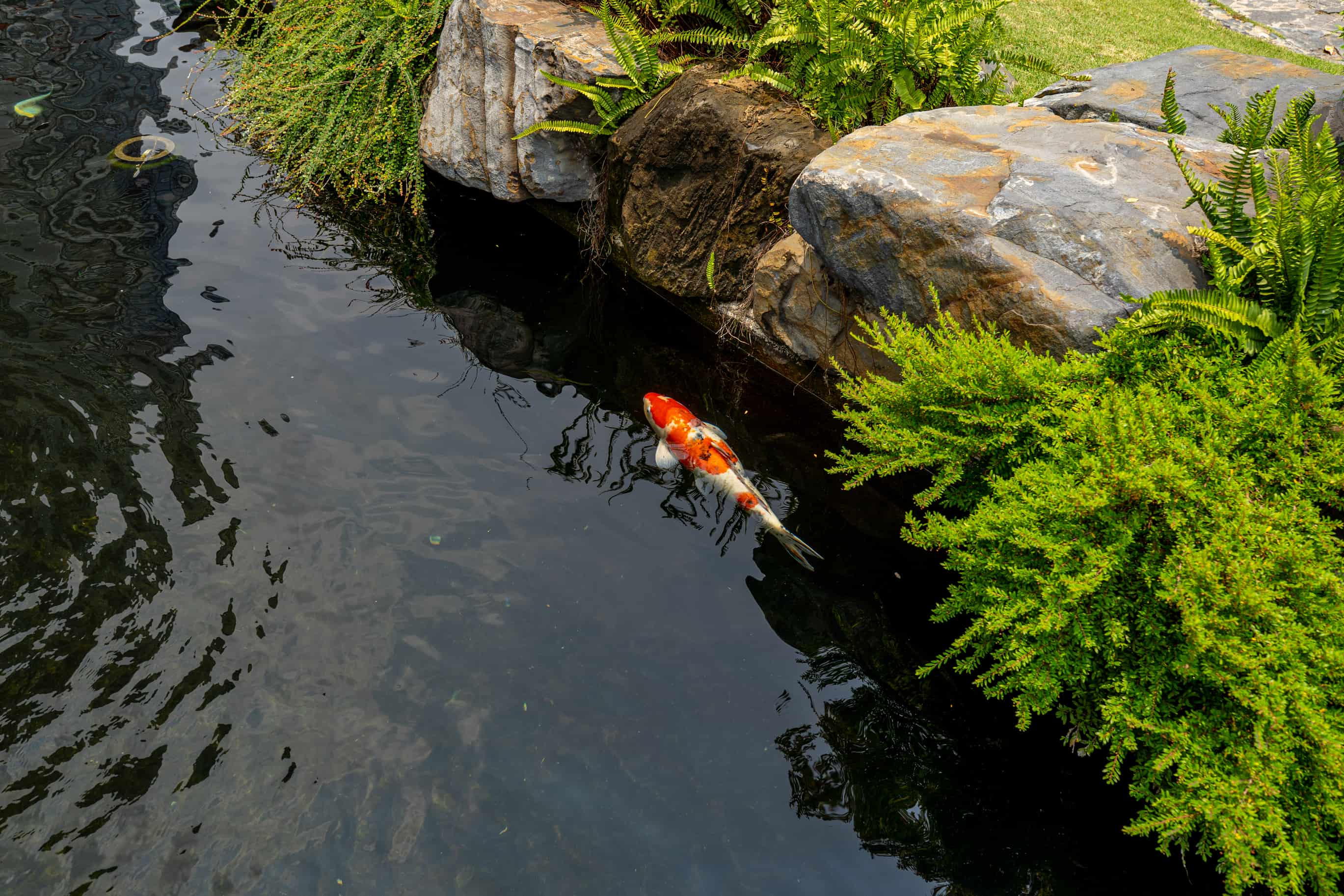
Sanke and Showa koi are nearly identical, and the one area that makes it a little easier to tell them apart is:
- Head Coloration
- Color Marking
Sanke koi only has the following two colors on their heads:
- Hi (Red)
- White
These species typically have black, red, and white on their bodies, with no black pigmentation on their heads.
A small Sanke koi (a couple of inches) can cost you as little as $150. However, a bigger high-quality specimen can cost you anywhere between $2,000 to $12,000, or if money is no problem, a wallet-emptying $40,000.
Showa
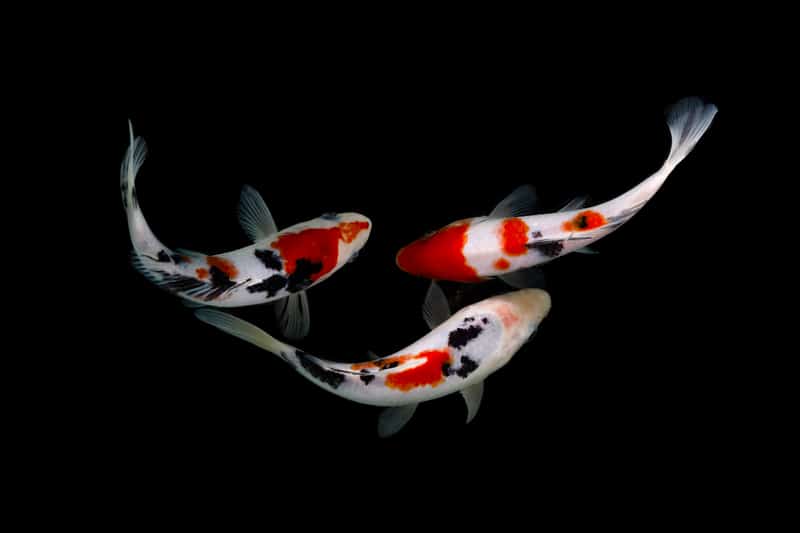
Showa koi is black, white, and orange-red for most of its existence. The swirly patches that these three colors create make them a koi favorite.
The patterns and placement vary from koi to koi; the more aesthetically pleasing the arrangement of colors, and the larger the fish, the higher the price.
Should you be interested in buying a Showa, be ready to part with loads of money, as they can be as little as a few hundred dollars to $21,000. Their average price will fluctuate between $4,000 to $15,000, depending on the quality of the koi.
Tancho
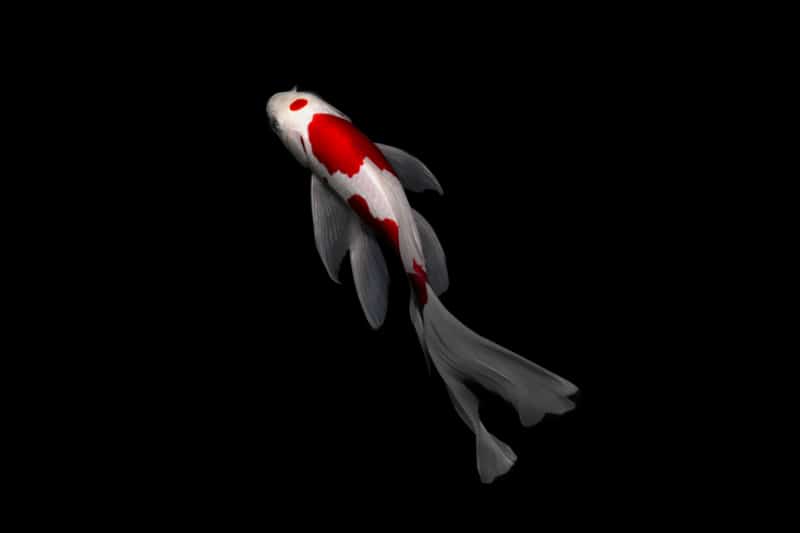
Tancho koi are held in very high esteem as they resemble the flag of Japan. If you are a very patriotic Japanese person, what could be more patriotic than a koi “flag” displaying itself in a pond? Tancho koi are found and accepted in the following koi breeds:
- Kōhaku
- Sanke
- Showa
Tancho koi is characterized by displaying a single red circle on top of their heads (red sun), and regardless of the breed or exact variety – as there are a few of them – this can be the only hi on the fish. There should be no other markings on a Tancho.
Other koi varieties can also display the red marking on their heads – Hariwake and Goshiki – but they will compete in different categories in a koi show. The color profile is very close to that of Kōhaku variations. Look out for a flawless, smooth white body that is unmarked.
The placement of the hi, together with the price, will often indicate that you are dealing with a Tancho. Expect to pay above $3,000 for such a koi. Even paying $8,000 to $10,000 is not unheard of when dealing with Tancho koi.
That being noted, you can get purchase some Tancho koi for as “little” as $1,000 to $1,500, and depending on the factors mentioned above, under $1,000 for a koi that has a few blemishes.
Doitsu

Doitsu koi is also called German koi, a well-beloved interbred species and a fairly pricey one to boot. Due to being so heavily interbred with numerous other koi species, it’s almost impossible to allocate any breeding standard regarding coloration.
Doitsu has very few scales, making them less shiny than other types of koi. When bred with other koi, species like scaleless Ginrin are one of the results, as well as multiple other species of koi.
Some of the more common Doitsu koi have black, white, and orange colors – similar to Sanke and Showa koi – and can cost a bit more than one’s with smaller bodies and darker colorations, for example:
- $799 to $5,000 for Doitsu Kohaku
- $799 to $6,000 for Doitsu Sanke
- $500 to $9,000 for Doitsu Showa
- $4,500 to $16,000 for Doitsu Kigoi
- $4,500 for Doitsu Gin
The higher-priced Doitsu listed above is of high quality. You will be able to buy low-quality small Doitsu for a couple of $100.
Beni Kikokuryu
This koi breed is also commonly referred to as Beni Kiko, a kind of koi that includes a wide range of colors, like the following:
- White
- Blue
- Silver
- Black
Beni Kikos can go under different names depending on their coloring. They will always have more than one color, though, and what sets them apart from other breeds is their metallic shine and scaleless body.
A very interesting actuality about Beni Kokos is that they can change color due to factors like a change in water temperature, for example. When buying one for your pond, always look at the sheen and skin luster, as this defines the breed’s quality.
Beni Kikokuro koi often reach quite a hefty price; however, you can pick them up for $400. For quality specimens, expect to pay between $2,000 to $5,000, depending on the usual factors. Beni Kikos are some of the most expensive koi found in any pond.
Asagi

Purebred Asagi tends to be luminous blue. However, splotches of hi (red) are not uncommon. The ones with more hi pigmentation are called Hi Asagi, and those who develop white lines next to the standard blue and red markings are called Taki Asagi.
As a breed of koi, Asagi is one of the oldest globally, and larger specimens fetch the highest prices. Their shimmering blue scales make them a highly sought-after addition in any koi pond, and while you can expect to pay $100 or less for a small one, the price rockets when color pigmentation occurs as they get older.
Prices can range from $700 to $3,500, depending on the color being silver-metallic or the more traditional blue tone. Technically speaking, an Asagi koi should have a white head, but they often portray a grey-toned head.
Utsuri
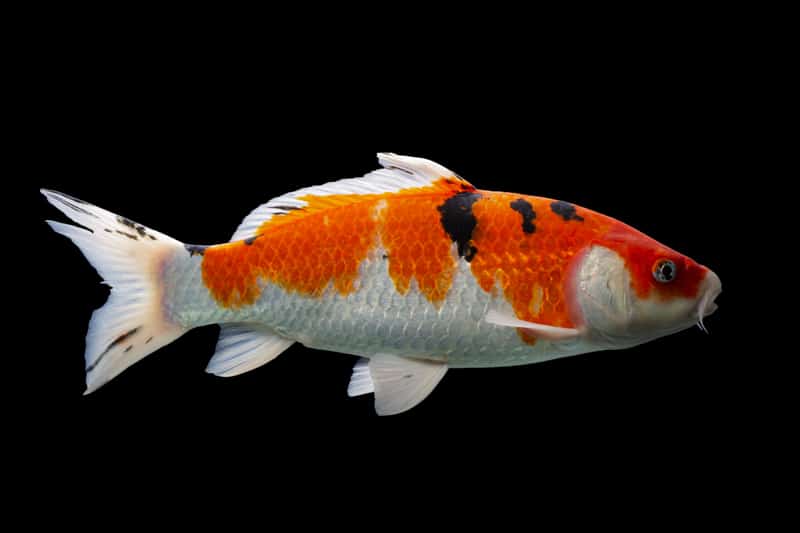
Utsuri koi is primarily black with at least one other color:
- Hi Utsuri is black with a red color.
- Ki Utsuri is black with yellow markings.
- Shiro Utsuri is black with white as a secondary color.
Secondary colors will vary; however, these koi are defined by the large segments of alternative pigmentation. The alternative colors must wrap around the koi’s body, and experts will look if the pattern elongates from the head to the tail. If this is not the case, the koi will be classified as an unideal Utsuri.
What’s cool about Utsuri koi is that the patterns found on the ideal Utsuri symbolize a Ying and Yang concept. Prices for Utsuri koi can have a drastic range, from $150 to $3,000, all dependent on breed, secondary color, size, and pattern.
If you are paying $8,000 for a Ki Utsuri or Hi Utsuri specimen, depending largely on the criteria listed above, the koi breeder and the koi retailer. If you are in the market for a high-quality Shiro Utsuri, expect to pay between $5,000 to $6,000.
Matsuba

Matsuba koi has a pattern that reminds the viewer of a pinecone, caused by scales with dark centers, and then outlined color edges displaying the color of the koi. These koi types are considered to be of one color.
They are members of the koi class called Hikari Muji – koi that has one solid color without any other markings – and can be given alternative names according to their color. With scales that glisten in direct sunlight, it’s a popular addition to any koi pond.
Matsuba koi can be purchased for as little as $120. However, their high-quality specimens can reach figures of up to $7,000 or more, depending on the koi’s lineage, breed, and color.
Show Quality Koi
If you’re interested in owning the most awesome koi collection in your pond, and you have a bank account full of thousands of dollars, the next list should be on your shopping list.
The guys at grandkoi.com, who claims to have “The finest imported Japanese koi from the best breeders in the world,” offers an excellent collection of koi to the American public from the following breeders:
- Hasegawa
- Isa
- Torazo
- Momotaro
- Dainichi
- Miyatora
- Marusei
- Sakai
- Koda
- Hosokai
- Kanishi
- Shinoda
- Sakazume
- Tarazo
- Marudo
- Max Koi Farm
- Saito Koi Farm
Here is the cost of show-quality koi that you can order from them:
- Kōhaku (32”) – bred by Momotaro – $19,999
- Kōhaku (32”) – bred by Momotaro – $24,999
- Maruten Kōhaku (32”) – bred by Dainichi – $24,999
- Maruten Showa (30”) – bred by Momotaro – $27,999
- Maruten Kōhaku (32”) – bred by Dainichi – $29,999
- Sanke (34”) – bred by Momotaro – $39,999
If the above list did nothing but fill you with envy, then you can give the guys at USA Koi a try, as they have a more budget-friendly collection of Japanese koi.
When you buy koi for your pond, the cheaper option will be any kind when they are small. The cheaper koi will not be high-quality fish – in the sense that they won’t be asked to participate in a koi show anytime soon.
If you are only interested in having some pretty-looking koi in your pond, then the cheaper koi should be your first option. When you want high-quality fish bred from a recognized breeder from a great lineage, big in size, and its coloration is close to perfect – you will have to pay accordingly.
Every koi breed mentioned above can produce very expensive specimens. On average, some will cost more and fall into a higher expense range than others consistently. Koi fish are expensive, and rightly so, it is an art to produce some of these magnificent-looking koi.
Conclusion
There are many koi breeds to choose from when adding to your pond collection. Small koi are usually the cheapest, especially those who don’t portray their species’ characteristics well.
Each breed has certain criteria that must be adhered to become expensive, such as lineage, correct coloration, size, breeding quality, and so forth. Koi fish can be a costly ornamental hobby. Luckily you get to decide the quality of koi you displayed in your pond.


